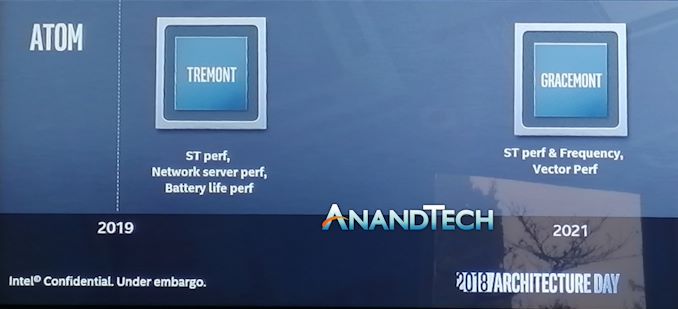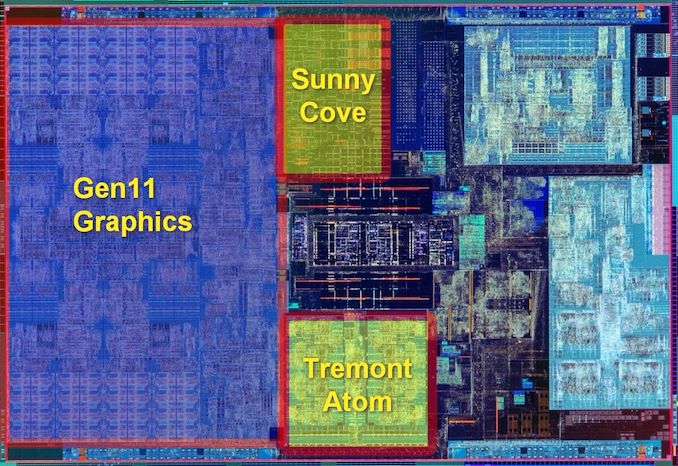The Intel Lakefield Deep Dive: Everything To Know About the First x86 Hybrid CPU
by Dr. Ian Cutress on July 2, 2020 9:00 AM ESTHybrid CPUs: Sunny Cove and Tremont
Now that we’ve gone over the concept of the heterogeneous core design, it’s time to dig into each of the cores separately and some of the tradeoffs that Intel has had to do in order to get this to work.
Big Sunny Cove
As mentioned previously, the big core in Lakefield is known as Sunny Cove, and stands as the same core we currently see in Intel’s Ice Lake mobile processors today. It is officially Intel’s second 10nm-class core (the first one being the DOA Cannon Lake / Palm Cove), but the first one in mass production.
We have covered the Sunny Cove core microarchitecture in great detail, and you can read about it here:
Examining Intel's Ice Lake Processors: Taking a Bite of the Sunny Cove Microarchitecture
The quick recap is as follows.
Very similar to a Skylake design, except that:
- Better prefetchers and branch predictors
- +50% L1 Data Cache
- +100% L1 Store Bandwidth
- +100% L2 Cache w/improved L2 TLB
- +50% Micro-op Cache
- +25% uops/cycle into reorder buffer
- +57% reorder buffer size
- +25% execution ports
- AVX-512 with VNNI
The side effect of increasing the L1 Data cache size was a decrease in latency, with the L1-D moving to a 5-cycle rather than a 4-cycle. Normally that would sound like a 25% automatic speed drop, however the increased L1 size, L1 bandwidth, and L2 cache all help for an overall improvement.
Intel claimed that Sunny Cove should perform ~18% better clock-for-clock compared to a Skylake core design. In our initial review of Ice Lake, we compared the i7-1065G7 processor (Ice Lake) to the Core i9-9900K processor (Coffee Lake, a Skylake derivative), and saw a 19% increase in performance per clock, essentially matching Intel’s advertised numbers.
(However it should be noted that overall we didn’t see that much of an improvement at the overall chip and product level, because the Ice Lake ran at a lower frequency, which removed any raw clock speed gain.)
Small Tremont Atom
Arguably the Tremont core is the more interesting of the two in the Lakefield design. Lakefield will be the first consumer product built with a Tremont core inside, and as a result we have not had a chance to test it yet. But we have gone over the microarchitecture extensively in a previous article.
Intel's new Atom Microarchitecture: The Tremont Core in Lakefield
The reason why Tremont is more exciting is because updates to Intel’s Atom line of processor cores happen at a much slower pace. Traditionally Atom has been a core that focuses on the low cost part of the market, so there isn’t that much of a need to make it right at the bleeding edge as it commands lower margins for the company. It still plays a vital role, but for context, here is what year we’ve seen new Atom designs come into the market:
- 2008: Bonnell
- 2011: Saltwell
- 2013: Silvermont
- 2015: Airmont
- 2016: Goldmont
- 2017: Goldmont Plus
- 2020: Tremont
Tremont is the first new Atom microarchitecture design for three years, and technically only the third Atom design to be an out-of-order design. However, Tremont is a big jump in a lot of under-the-hood changes compared to Goldmont Plus.
- Can be in a 1-core, 2-core, or 4-core cluster
- +33% L1-Data Cache over Goldmont+, no performance penalty
- Configurable L2 cache per cluster, from 1.5 MB to 4.5 MB
- +50% L2 TLB (1024-entry, up from 512)
- New 2x3-wide decoder, rather than single 3-wide decoder
- +119% re-order buffer (208, up from 92)
- 8 execution ports, 7 reservation stations
- 3 ALUs, 2 AGUs
- Dual 128-bit AES units
- New Instructions*
What made the most noise is the new dual 3-wide decoder. On Intel’s primary Core line, we haven’t seen much change in the decoder in recent generations – it still uses a 5-wide decoder, split between 1 complex decoder and 4 simple decoders, backed with a micro-op cache. Tremont’s new dual 3-wide decoder can manage dual data streams in order to keep the buffers further down the core fed. Intel stated that for the design targets of Tremont, this was more area and power efficient than a 6-wide decoder, or having a large micro-op cache in the processor design (Atom cores have not have micro-op caches to date). Intel states that the decoder design helps shape the back-end of the core and the balance of resources.
Also worthy of note in Tremont is the L1-Data cache. Intel moved up from a 24 KiB design to a 32 KiB design, an increase of 33%. This is mostly due to using the latest manufacturing node. However, an increase in cache size is typically accompanied with an increase in latency – as we saw on Sunny Cove, we moved from a 4-cycle to a 5-cycle. However in Tremont’s case, the L1-Data cache stays at 3-cycle for an 8-way 32 KiB design. Even Skylake’s L1-D cache, at an 8-way 32 KiB design, is a 4-cycle, which means that Tremont’s L1-D is tuned to surpass even Skylake here.
The final point, Tremont’s new instructions, requires a section all on its own, specifically because none of the new instructions are supported in Lakefield.
What’s Missing in Lakefield
One of the biggest issues with a heterogeneous processor design is software. Even if we go beyond the issues that come with scheduling a workload on such a device, the problem is that most programs are designed to work on whatever microarchitecture they were written for. Generic programs are meant to work everywhere, while big publishers will write custom code for specific optimizations, such as if AVX-512 is detected, it will write AVX-512.
The hair-pulling out moment occurs when a processor has two different types of CPU core involved, and there is the potential for each of them to support different instructions or commands. Typically the scheduler makes no guarantee that software will run on any given core, so for example if you had some code written for AVX-512, it would happily run on an AVX-512 enabled core, but cause a critical fault on a core that doesn’t have AVX-512. The core won’t even know it’s an AVX-512 instruction until it comes time to decode it, and just throw an error when that happens. Not only this, but the scheduler has the right to move a thread when it needs to – if it moves a thread in the middle of an instruction stream, that can cause errors too. The processor could also move a thread to prevent thermal hotspots occurring, which will then cause a fault.
There could be a situation where the programmer can flag that their code has specific instructions. In a program with unique instructions, there’s very often a check that tries to detect support, in order to say to itself something like ‘AVX512 will work here!’. However, all modern software assumes a homogeneous processor – that all cores will support all of the same instructions.
It becomes a very chicken and egg problem, to a certain degree.
The only way out of this is that both processors in a hybrid CPU have to support the same instructions completely. This means that we end up with the worst of both worlds – only instructions supported by both can be enabled. This is the lowest common denominator of the two, and means that in Lakefield we lose support for AVX-512 on Sunny Cove, but also things like GFNI, ENCLV, and CLDEMOTE in Tremont (Tremont is actually rather progressive in its instruction support).
Knowing that Lakefield was going to have to take the lowest common denominator from the two core designs, Intel probably should physically removed the very bulky AVX-512 unit from the Sunny Cove core. Looking at the die shot, it's still there - there was some question going into the recent disclosures as to whether it would still be there, but Intel has stated on the record repeatedly that they removed it. The die shot of the compute silicon shows that not to be the case.
For x86 programmers doing instruction detection by code name or core family, this might have to change. In the smartphone world, where 4+4 processor designs are somewhat the norm, this lowest common denominator issue has essentially been universally adopted. There was some slight issue with a Samsung processor that had a non-unified cache setup, which ended up being rectified in firmware. But both sets of CPUs had to rely on lowest common denominator instructions.













221 Comments
View All Comments
SarahKerrigan - Thursday, July 2, 2020 - link
Not only does it not have AVX-512, it appears to have no AVX at all. For a premium product in 2020, that's embarrassing.shabby - Thursday, July 2, 2020 - link
Atom... premium? Don't be silly 😆SarahKerrigan - Thursday, July 2, 2020 - link
Hey, I agree, but it's going into devices that start at US$1k. It's clearly being positioned as a premium chip, despite showing every sign of not actually being very good.shabby - Thursday, July 2, 2020 - link
It'll be a tough sell that's for sure.Smell This - Thursday, July 2, 2020 - link
No where to go but up ... or 6.5 years back:HP Pavilion TouchSmart 11-e115nr - 11.6"
AMD A6-1450 7w 'Temash' - 8 GB RAM - Samsung SSD
CB15: 109
OpenGL: 10.42
http://dude-gotta-go.com/images/AMD-A6-1450-Temash...
Ice Storm 1.2: 20243
http://dude-gotta-go.com/images/AMD-A6-1450-Temash...
Fire Strike 1.1: 236
http://dude-gotta-go.com/images/AMD-A6-1450-Temash...
eastcoast_pete - Thursday, July 2, 2020 - link
Yes, premium this ain't. Really disappointed, as I see this overall concept as being the most innovative thing to come out of Intel in a long time. However, this way - no dice.sharath.naik - Friday, July 3, 2020 - link
Worst is the cinebench r15 scores of 89 and 250 for single and multi thread scores. That's ridiculous, you can actually undervolt and power limit a i5-1035G7 and still get at least twice the performance in single thread.dersteffeneilers - Saturday, July 4, 2020 - link
Well the thing goes into laptops smaller than phones, if it's pulling <2W during bursts, it's gonna overheat really badly.Spunjji - Monday, July 6, 2020 - link
So they've sacrificed speed *and* cost-effectiveness for area. Oh dear.ProDigit - Friday, July 3, 2020 - link
It would be, if you paired 100 of them together.